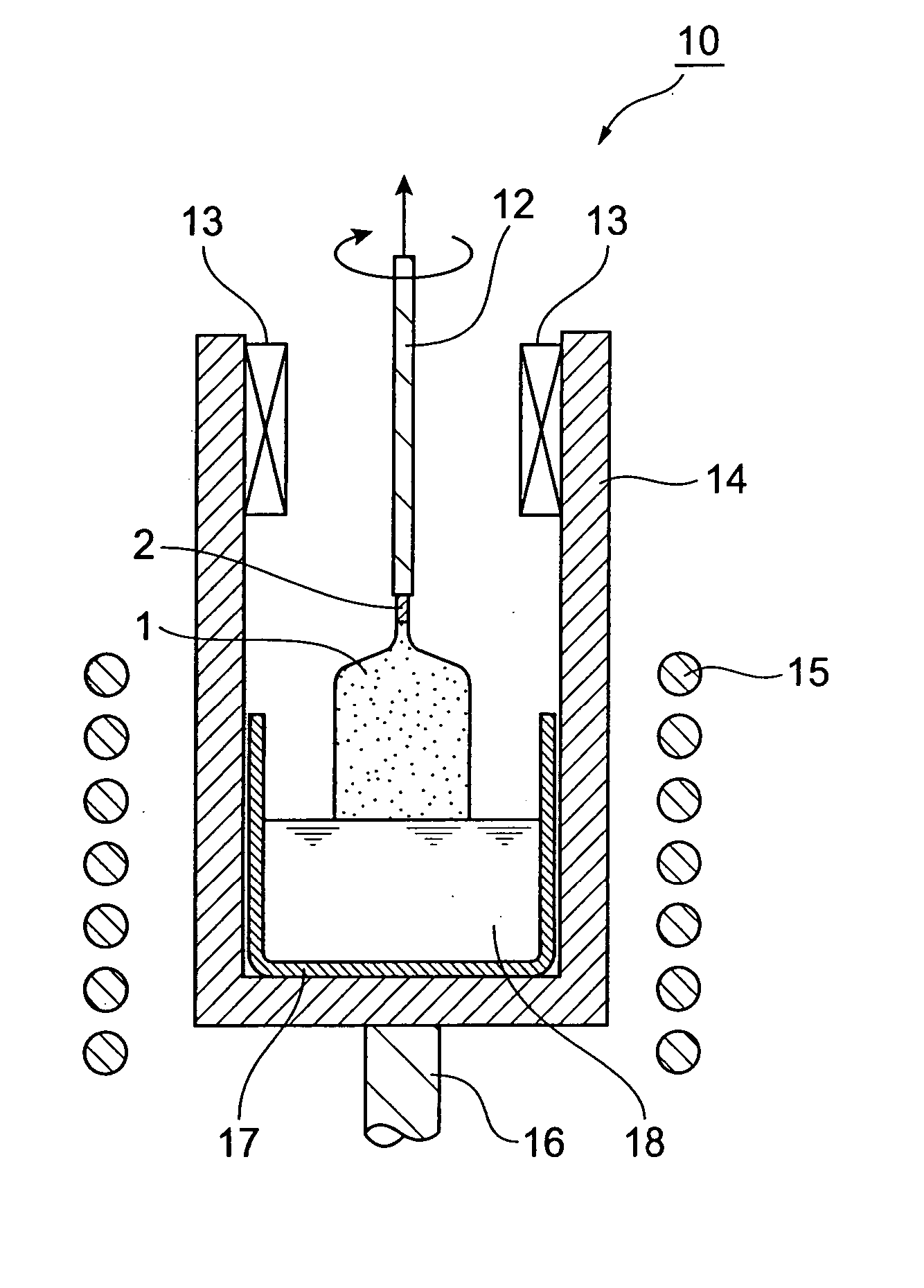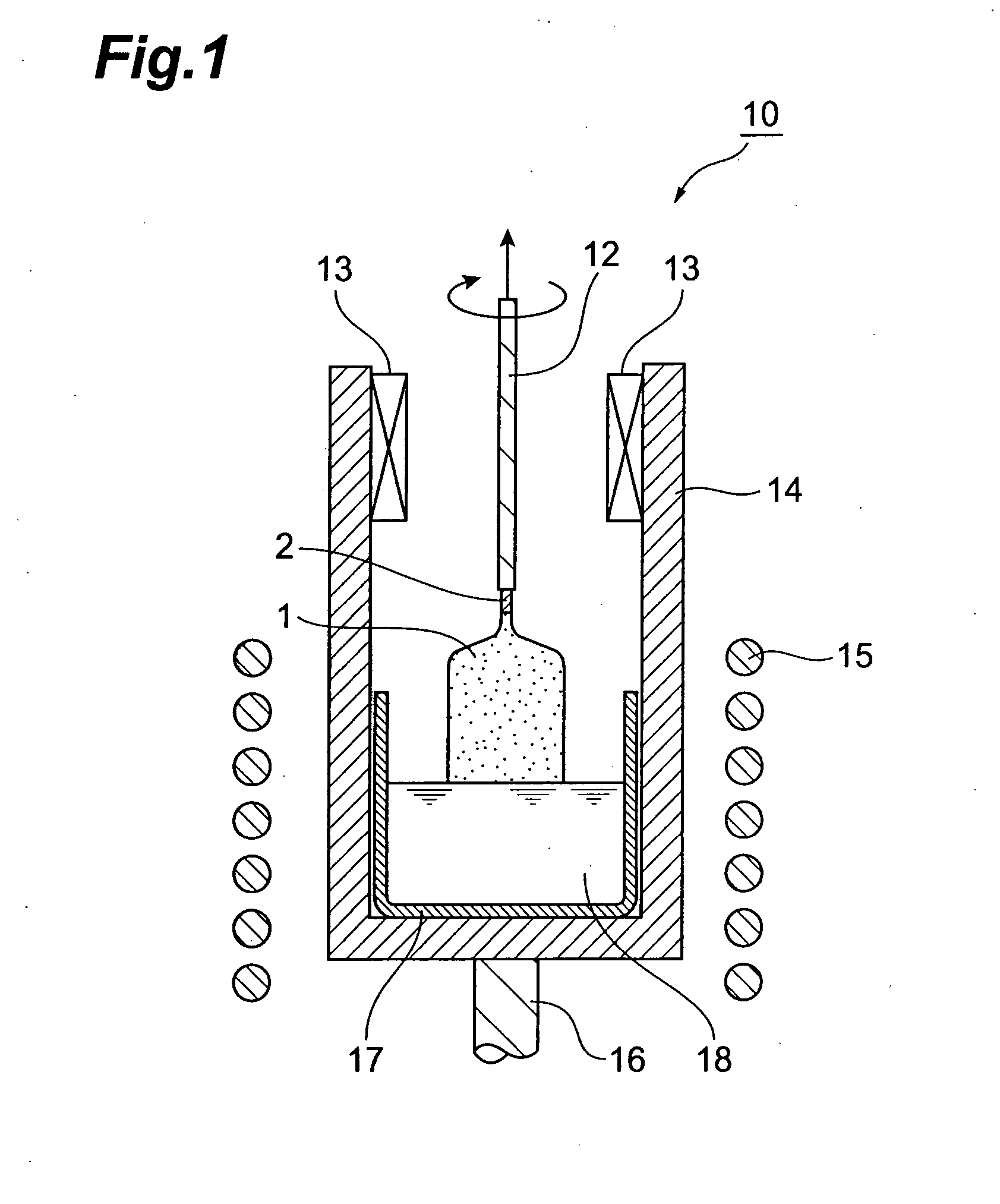Scintillator single crystal and process for its production
a single crystal, scintillator technology, applied in the direction of crystal growth process, polycrystalline material growth, silicon compound, etc., can solve the problem of difficult to achieve stable light output properties, and achieve the effect of reducing the luminescent wavelength transmittance, increasing the variation of light output, and reducing the light outpu
- Summary
- Abstract
- Description
- Claims
- Application Information
AI Technical Summary
Benefits of technology
Problems solved by technology
Method used
Image
Examples
example 1
[0073] A single crystal was produced by the publicly known Czochralski process. First, 500 g of a mixture of gadolinium oxide (Gd2O3, purity: 99.99 wt %), lutetium oxide (Lu2O3, purity: 99.99 wt %), silicon dioxide (SiO2, purity: 99.9999 wt %) and cerium oxide (CeO2, purity: 99.99 wt %), in the prescribed stoichiometric composition, was prepared and loaded in an Ir crucible with a diameter of 50 mm, a height of 50 mm and a thickness of 2 mm, as the starting material for a Gd2-(r+s)LurCesSiO5 (r=1.8, s=0.003) single crystal. The tetra-, penta- and hexavalent elements (impurities) in the respective starting materials for gadolinium oxide, lutetium oxide and silicon dioxide were all less than 1 ppm by weight.
[0074] The mixture was then heated to the melting point (about 2050° C.) in a high-frequency induction heating furnace to obtain a melt. The melting point was measured using an electronic optical pyrometer (Pyrostar MODEL UR-U™ by Chino Corp.).
[0075] Next, the end of the lifting ...
example 2
[0079] First, 500 g of a mixture of gadolinium oxide (Gd2O3, purity: 99.99 wt %), lutetium oxide (Lu2O3, purity: 99.99 wt %), silicon dioxide (SiO2, purity: 99.9999 wt %) and cerium oxide (CeO2, purity: 99.99 wt %), in the prescribed stoichiometric composition as the starting materials for a Gd2-(r+s)LurCesSiO5 (r=1.8, s=0.003) single crystal, was loaded in an Ir crucible with a diameter of 50 mm, a height of 50 mm and a thickness of 2 mm, together with 0.0881 g of calcium carbonate (CaCO3, purity: 99.99 wt %) (corresponding to 0.0070 wt % as Ca). The tetra-, penta- and hexavalent elements (impurities) in the respective starting materials for gadolinium oxide, lutetium oxide and silicon dioxide were all less than 1 ppm by weight. The procedure thereafter was conducted in the same manner as Example 1.
example 3
[0080] A single crystal of Y2-(x+y)LuxCeySiO5 (x=1.8, y=0.003) instead of the Gd2-(r+s)LurCesSiO5 (r=1.8, s=0.003) in Example 1 was produced in the following manner. Yttrium oxide (Y2O3, purity: 99.99 wt %) was used instead of the gadolinium oxide (Gd2O3, purity: 99.99 wt %) used in Example 1, and into 500 g of a mixture with the prescribed stoichiometric composition there was loaded 0.0804 g of calcium carbonate (CaCO3, purity: 99.99 wt %) (corresponding to 0.0072 wt % of Ca) in the same manner as Example 2. The tetra-, penta- and hexavalent elements (impurities) in the respective starting materials for yttrium oxide, lutetium oxide and silicon dioxide were all less than 1 ppm by weight. The procedure thereafter was conducted in the same manner as Example 1.
PUM
| Property | Measurement | Unit |
|---|---|---|
| temperature | aaaaa | aaaaa |
| temperature | aaaaa | aaaaa |
| melting point | aaaaa | aaaaa |
Abstract
Description
Claims
Application Information
 Login to View More
Login to View More - R&D
- Intellectual Property
- Life Sciences
- Materials
- Tech Scout
- Unparalleled Data Quality
- Higher Quality Content
- 60% Fewer Hallucinations
Browse by: Latest US Patents, China's latest patents, Technical Efficacy Thesaurus, Application Domain, Technology Topic, Popular Technical Reports.
© 2025 PatSnap. All rights reserved.Legal|Privacy policy|Modern Slavery Act Transparency Statement|Sitemap|About US| Contact US: help@patsnap.com


